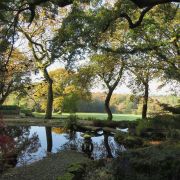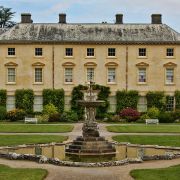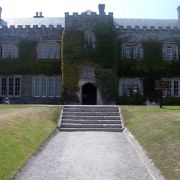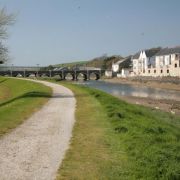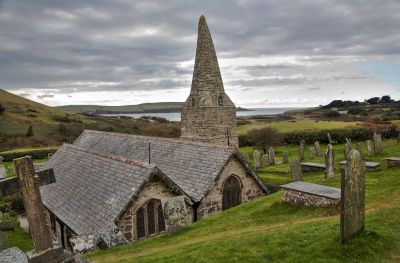
A grade I listed building, St Enodoc Church is located overlooking the River Camel river mouth in the village of Trebetherick, between Polzeath and Rock. Restored in the mid-Victorian period, the church maintains its original Early English vernacular style of architecture. Built largely from stone rubble, it is said to be the place where Saint Enodoc sought refuge during the sixth century AD, although most of the evidence (including the granite baptismal font) points to the church being a twelfth century structure.
Having what most would call a commanding position in the Cornish countryside, it sits amid the green of the tenth hole of the local golf course just behind the beach at Daymer Bay. The rolling lawns that wrap around the church are actually seeded sand dunes which have entirely engulfed St Enodoc's several times over the centuries. For this reason the church has on occasion been referred to as "Sinking Neddy" with it being submerged in sand for years at a go. At one point, the dunes became so bad the parish priest had to attend to his congregation by being lowered through a hole in the slate roof.
The tranquil churchyard contains the grave of Sir John Betjeman, the poet laureate from 1972 until 1984. He had referenced the church in his poem Sunday Afternoon Service at St. Enodoc. Several of the other burials are themselves grade II listed.
Sunday Afternoon Service at St. Enodoc
Come on! Come on! This hillock hides the spire,
Now that one and now none. As winds about
The burnished path through lady’s-finger, thyme,
And bright varieties of saxifrage,
So grows the tinny tenor faint or loud
All all things draw toward St. Enodoc.
Come on! Come on! and it is five to three.
Still, Come on! come on!
The tinny tenor. Hover-flies remain
More than a moment on a ragwort bunch,
And people’s passing shadows don’t disturb
Red Admirals basking with their wings apart.
A mile of sunny, empty sand away,
A mile of shallow pools and lugworm casts.
Safe, faint and surfy, laps the lowest tide.


